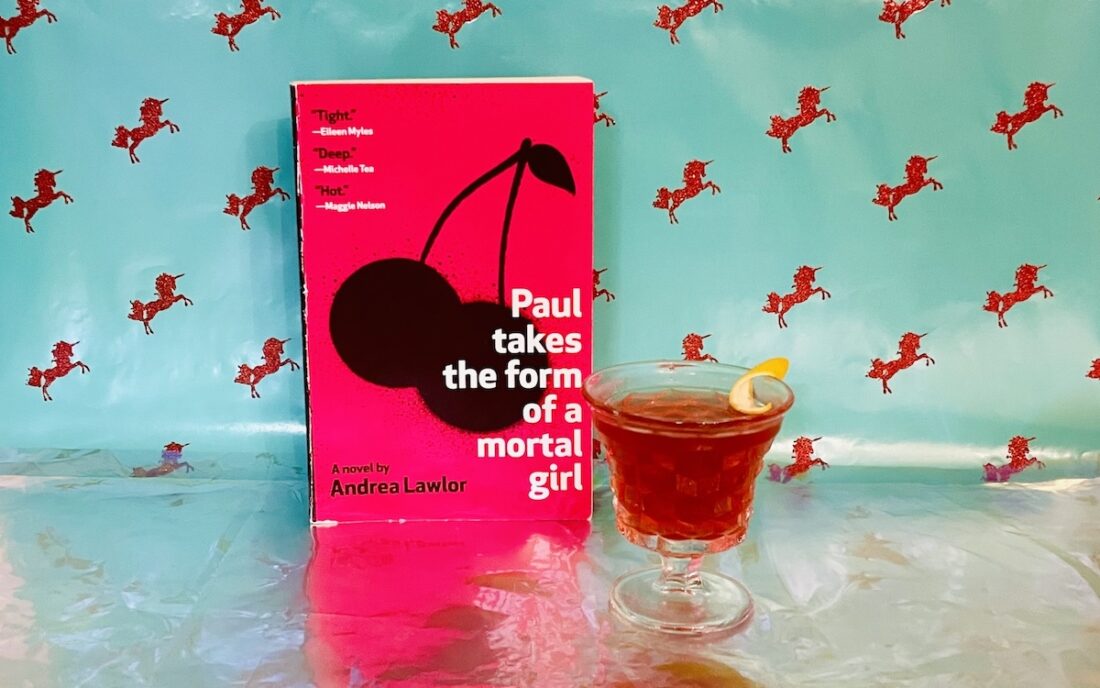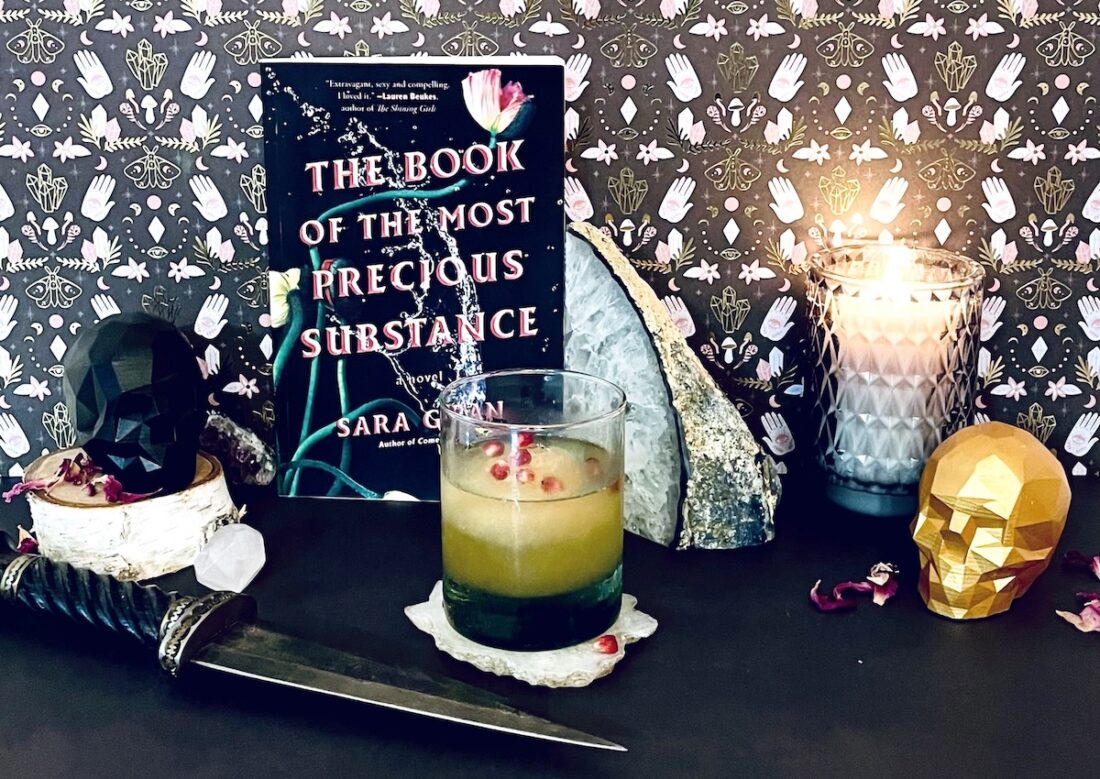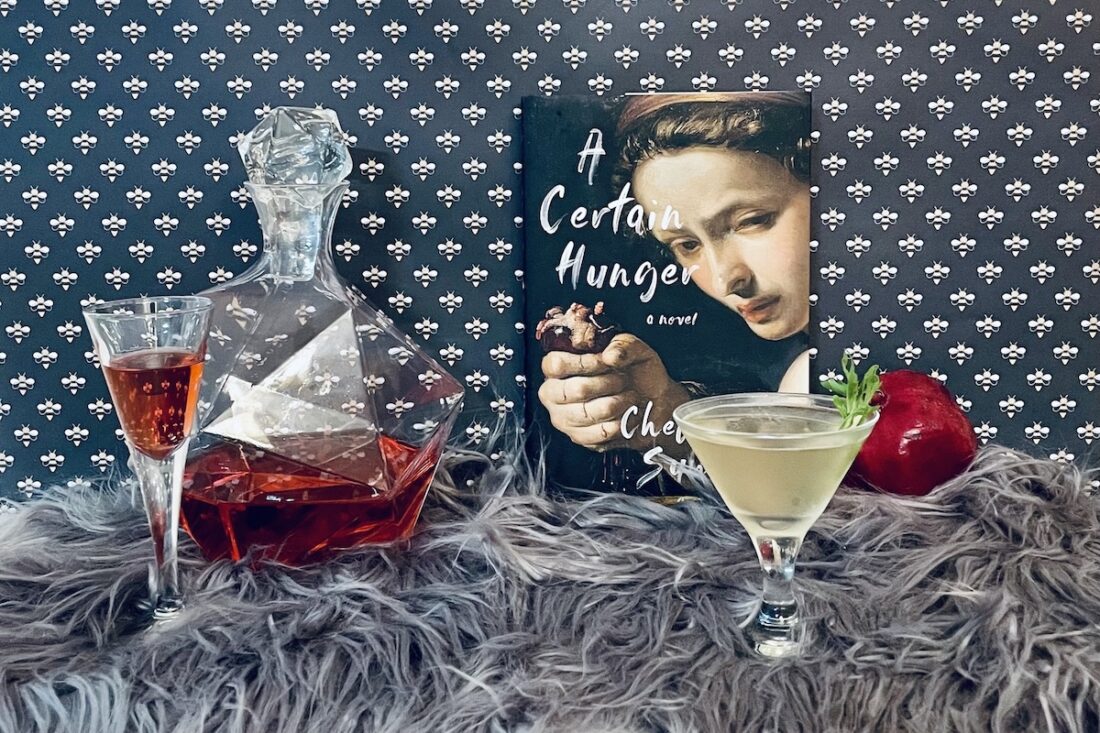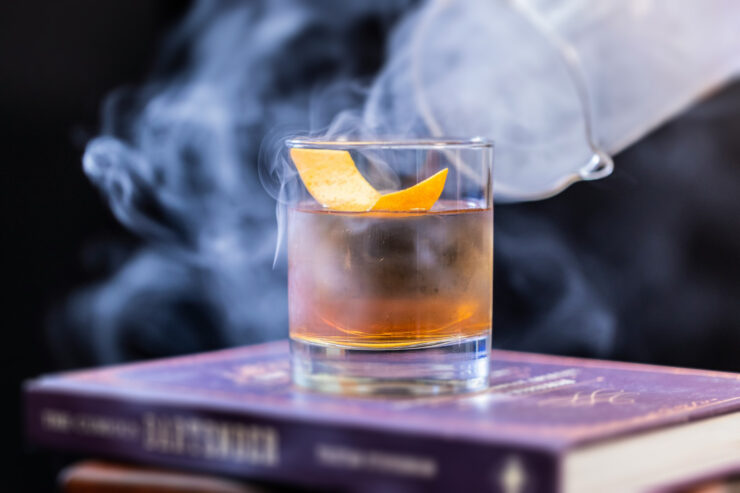Imagine a pair of polyamorous emotional vampires from San Francisco on a queer-themed cruise around the Black Sea. My forthcoming novella, Vampires at Sea (a smutty, horror-comedy “snack” coming from feminist horror small press Creature Publishing in the spring of 2025!) follows vampires Hugh and Rebekah as they encounter an alluring third partner, a non-binary social media influencer named Heaven. Sex and mayhem ensue, against a backdrop of ongoing war.
Several unabashedly queer, sexy, and magical novels influenced the conception of Vampires at Sea, including: Anne Rice’s classic Interview with the Vampire but of course; Paul Takes the Form of a Mortal Girl, a queer tale of shapeshifting by Andrea Lawlor; Sara Gran’s sexy, spell-casting The Book of the Most Precious Substance; and the deliciously dangerous A Certain Hunger by Chelsea G. Summers. What follows is a look at each of these risk-taking books—plus a cocktail recipe for each! In addition to being an author, I’m also a mixologist, and part of my practice includes “booktails”—custom drink recipes with ingredients derived from the books’ moods, themes, and symbolism–a tangible expression of the novel’s influence. Besides, cocktails are a proper seduction in their own right, and a celebration of decadence. So, I hope you’re thirsty, readers. Cheers! Let’s dive in.
Interview with the Vampire

Disclaimer! If you’ve only seen the AMC series but not yet read the novel, be prepared for some key differences, particularly when it comes to Claudia’s role. In altering the family dynamic, the show created a whole other narrative that plays by its own rules. Personally, I prefer the book to the series. That’s just my opinion, though! I recommend exploring both!
In Rice’s 1976 novel, Louis de Pointe du Lac was once heir to a New Orleans plantation. He was also a slave owner. His maker is Lestat, a charming and impetuous narcissist, who taunts Louis’ moral struggles. Lestat’s cruelest and most elegant trap is the creation of their vampire daughter, Claudia, whose mind ages, though her little toddler body does not.
While writing Vampires at Sea, I thought a lot about the gay-family-love-triangle in Rice’s novel: Lestat, the unabashedly monstrous vampire who’s afraid to be alone; Louis, the self-loathing vampire victimized by Lestat; and Claudia, a self-accepting monster, nevertheless plagued by an unfulfilled need to achieve physical maturity. Her vampire body is a prison; it cannot last. (Side note: in the book, the break-up scene between Louis and Armand is also one of the coldest splits I’ve ever seen. Take a look–reality romance TV has nothing on these two.)
If you’ve only seen the AMC series but not yet read the novel, be prepared for some key differences, particularly when it comes to Claudia’s role. In altering the family dynamic, the show created a whole other narrative that plays by its own rules. Personally, I prefer the book to the series. That’s just my opinion, though! I recommend exploring both!
The Red Lavender cocktail is full of flowers: like a child, Claudia is covered in lavender while she persuades Louis to accept her murderous machinations. Orange blossom water scents Louis’ midnight strolls with his sister, now lost to mortality. Bittersweet botanicals complement these florals. The glass is rinsed with licorice-y absinthe: when Claudia executes her doomed plan, she employs two little cherubs, some laudanum, and absinthe, with terrible results. Herbaceous Campari adds a brilliant red, reminiscent of Armand’s auburn curls. All of this is topped with champagne, a favorite prop of Lestat’s when he’s performing humanness.
Red Lavender
- Dry champagne
- 1 oz Campari
- 0.5 oz lavender syrup (see recipe)
- 1 tsp absinthe
- A dash orange blossom water
Instructions: Prepare the lavender syrup. Meanwhile, set a coupe glass in the freezer or at the back of the fridge to chill. Once the syrup is cool and the glass is frosted, rinse with absinthe, coating the glass thoroughly and discarding the excess. Set aside. Add the Campari, lavender syrup, and orange blossom water to a mixing glass with ice. Stir vigorously, then strain into the chilled glass. Top generously with champagne.
Lavender Syrup
- 1 c water
- 1 c sugar
- ¼ c dried organic lavender
Instructions: Mix all ingredients together in a small pot, then bring to a boil. Let simmer for 15-20 minutes, stirring occasionally. Once cool, strain and discard solids. Store ininto a glass bottle or jar. Keep refrigerated.
Paul Takes the Form of a Mortal Girl

Andrea Lawlor’s Paul Takes the Form of a Mortal Girl is a magical odyssey traversing the queer side of the 90’s, contextualized by the ongoing AIDS crisis. (Also, it’s the only book on this list where no one gets murdered!) Our guide through Iowa City, the Michigan Womyn’s Fest, P-Town, and the gayest city of all, San Francisco, is the eponymous Paul, a lovably superficial sort-of intellectual, with penchants for fashion and sex of all kinds with all genders. Haphazardly enrolled in college courses, Paul scrapes by with earnings from bars and bookstores, all the while hunting for potential sexual conquests. Paul’s good at conforming to his prey’s particular taste. Really, really good. Paul’s a shapeshifter, in fact. He can change his physical appearance at will, altering his hair, musculature, breast tissue, and sex. Then he falls for Diane, a gold star lesbian, who wants him to live as female-bodied. Does Paul know who he is? What he is?
Lawlor does not explain how Paul became Paul. Instead, various myths pop up throughout the narrative. The author told the Boston Review they sought to challenge the very idea of an origin story:
“[…] I think a lot of queer and trans people resent constantly being forced to come up with a cohesive narrative. For example, there is this by-the-book trans narrative I could give: ‘I always felt like I was a boy,’ or ‘When I was four years old…’ All that may be true, but it is also more complicated.”
This novel refuses to explain itself in terms of its queerness, smuttiness, or cultural references. And I, for one, am here for it.
The Shapeshifter is made with bourbon infused with peach–one of the sexiest fruits–which transforms not only the flavor, but the color and viscosity. Paul often reaches for whiskey, as when Diane surprises him in boy form or when it takes a gratis whiskey sour for Paul to summon the courage to listen to voicemails from his ex-boyfriend, Tony Pinto. And when grief hits, he drinks whiskey under the covers. Meanwhile, the Luxardo adds a touch of cherry–another sexy fruit, there’s even one on the cover. All are balanced by the herb-y bitterness of the Italian aperitivo, a nod to the Negroni, Tony’s favorite drink. Finally, the lemon twist adds a sharp, refreshing note. The cumulative result is surprisingly harmonious.
Shapeshifter
- 2 oz peach-infused bourbon (see instructions)
- 1 oz Martini & Rossi Aperitivo (red variety, nonalcoholic)
- 0.5 oz Luxardo maraschino liqueur
- Lemon twist
Instructions: Add 1 fresh sliced peach to a jar, with the skin, plus 1 c bourbon. Seal, shake, and let sit in a cool, dark place for 3-7 days. Shake once daily. Strain and discard solids. Add the bourbon to a mixing glass with ice, along with the Luxardo and Aperitivo. Stir then strain into a stemmed glass and garnish with a lemon twist.
The Book of the Most Precious Substance

People will tell you Sara Gran’s The Book of the Most Precious Substance is about female ejaculation. That’s just not true. Yes, the plot involves female ejaculation/squirting–but it’s just a tool for working some dark magic.
You see, Lily Albrecht is a celebrated author who’s stopped writing. Her once-brilliant husband has succumbed to inexplicable dementia, requiring round-the-clock care. If Lily can find the rarest of rare books, a magical tome called The Book of the Most Precious Substance, she just might get her beautiful life back. The search itself is a riveting and sumptuously nourished treasure hunt through the US and Europe. There are side adventures and an array of magical characters, including witches. Occult knowledge is likewise peppered throughout, which I very much appreciate.
There is indeed something very witchy about this book. Even its origin story is kind of magical: Sara Gran started Dreamland Books to publish it. She told LitHub:
“…I just knew it would be a shit show one way or the other. There would be some form of picking on what I had done. Either it would be, ‘Put more sex into it and make it straightforward erotica,’ or it would be, ‘This is too much sex and the sex is too weird, and it involves things that some people don’t believe exists, and we can’t have that either.’ ”
Gran decided to write “exactly what I wanted to write, with all of that sex, with all of the other sort of occult stuff in it, all of the stuff that someone in a New York publishing house might not quite grasp, and just get it out there.” These are not things authors are encouraged to do; we’ve got gatekeepers, agents, editors, and others to consider. Gran inspires us to trust ourselves and our authorial instincts. Write that orgy.
Each layer of the Precious Potion represents one of the “materials” required to complete the spell and achieve Lily’s goal. First, plum brandy (get it?) stands in for semen. Clear, refined brandy is also known as eau de vie–water of life. (In Sumerian mythology, water is a metaphor for man’s seed.) Honey—like the honey drizzled over the cheese Lily enjoys in New Orleans, or sold at an open air market in Munich—references natural lubrication, while lemon juice embodies sour sweat. The Floral bitters represent the elusive substance that requires a bit of magic to achieve. These bitters combine several witchy plants used in healing and spells: lavender, chamomile, calendula, and wormwood. Lastly, pomegranate seeds, the Greek fruit of the dead, reference a certain meaningful tattoo. The seeds also symbolize the final step to complete the spell, one which requires the most precious substance of all–life.
Precious Potion
- 2 oz plum brandy/eau de vie
- 2 Tbsp honey dissolved in 1 Tbsp hot water
- 0.5 oz fresh lemon juice
- Several dashes Strongwater Lavender Wildflower bitters
- Pomegranate seed garnish
Add the brandy, dissolved honey, lemon juice, and bitters to a shaker with ice. Agitate vigorously for about 20 seconds, then strain into a rocks glass with a large ice cube. Garnish with pomegranate seeds.
A Certain Hunger

In Chelsea G. Summers’ deliciously cheeky novel A Certain Hunger, food critic Dorothy Daniels harbors a secret indulgence: killing and cannibalizing her lovers. Her alliterative name seems like a deliberate nod to Humbert Humbert from Nabokov’s Lolita– another slippery monster, gorging on the souls of young girls. Except Dorothy doesn’t care about your approval. Instead, she confronts the complicit reader, hungrily turning the pages of her tale of sex and violence. The theme here is “consumption.” Gorgeous prose renders delicacies perverse, aligning oysters and anal in the same sentence. (In Vampires at Sea, it’s human feeling that’s so delectable. Tangible meals are both a curiosity and a grotesquerie.)
The Martini Rucola Basilico is made with gin, the base ingredient of the Corpse Reviver #2. This is the same cocktail Dorothy enjoys at the hotel bar where she meets the man who will be her undoing. The floral gin is complemented by a spicy, herbaceous arugula basil cordial. Arugula appears both in the last meal Dorothy serves her lover Gil, and the one she makes of his lingua. Basil is also a must, given Dorothy’s Italian passion. Dry vermouth adds a crisp touch, tempering the sweet cordial and gin. Despite the vibrant green of the herbs, the cocktail is eerily translucent, the single curl of arugula garnishing the glass the only clue to his ingredients.
Martini Rucola Basilico
- 2 oz gin (I prefer Botanist gin)
- 1 oz arugula basil cordial (see recipe)
- 0.5 oz dry vermouth
- Arugula leaf garnish
Instructions: Prepare the cordial. Meanwhile, set a martini glass in the freezer to chill. Once the cordial is ready, add it to a mixing glass with ice, along with the gin and vermouth. Stir, then strain into the chilled glass. Garnish with a fresh leaf of arugula.
Arugula Basil Cordial
- 1 c sugar
- 1 c water
- ⅓-1 c vodka
- ¼ c arugula (whole leaf)
- ¼ c fresh basil (whole leaf)
Instructions: Combine the sugar and water in a small pot. Bring to a boil, then reduce heat and simmer for five minutes, stirring occasionally. Gently mix in the arugula and basil, then cover and let cool. Strain and discard solids. Add the syrup to a jar, along with an additional handful of fresh arugula and a stem of fresh basil fresh. Add ⅓-1 c vodka (⅔ c is recommended). Seal and shake the jar. Let sit in a cool, dark place for 3-7 days. Shake once per day. Strain and discard solids. Store in a glass bottle or jar.










